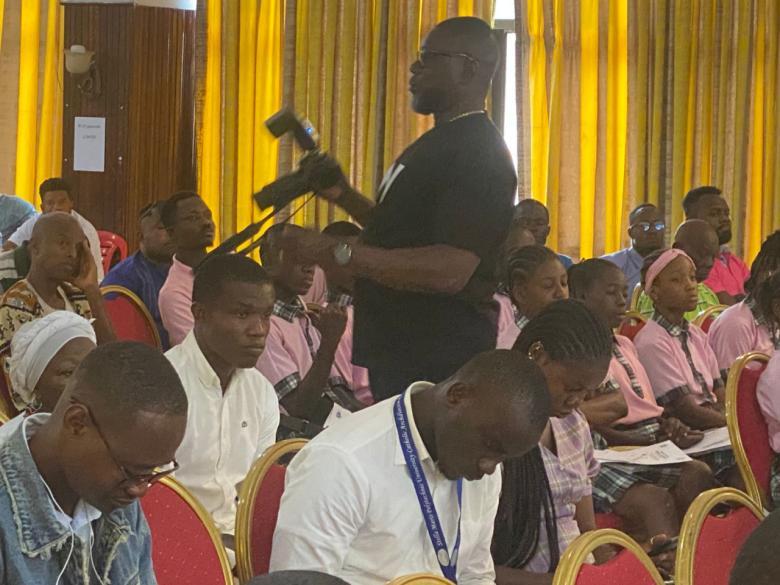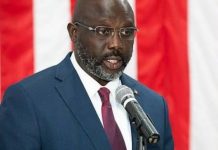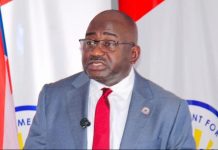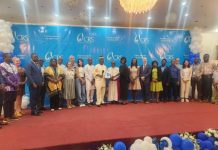Africa-Press – Liberia. The Liberia Electricity Regulatory Commission (LERC) on Wednesday, November 19, 2025 convened a major public hearing at the Monrovia City Hall to review the Liberia Electricity Corporation’s (LEC) application for a new electricity tariff.
The event brought together government officials, development partners, sector stakeholders, civil society actors, and residents eager to understand the proposed tariff adjustments and the future of electricity supply in Liberia.
The hearing is a legal requirement under the 2015 Electricity Law of Liberia, which mandates that any tariff charged by a licensed operator must be reviewed and approved by LERC following public consultations.
LERC: Ensuring Fairness, Transparency and Balance
Delivering the opening statement on behalf of the Commission, Alieu Fuad Nyei, Director of Economic Regulation, underscored the purpose of the hearing: to create a transparent forum where LEC, LERC, and consumers can openly engage on tariff issues.
He emphasized that the law requires LEC already a fully licensed utility to submit applications for tariff adjustments, which are then vetted through a multi-step process including completeness checks, stakeholder consultations, and public hearings.
“This hearing allows the public to understand how the tariff was derived, ask questions, and raise concerns,” he said. “Your participation is vital for ensuring transparency, fairness, and accountability.”
Commission Chair: “We Don’t Want LEC to Cheat the People and We Don’t Want the People to Cheat LEC”
In his presiding remarks, Claude J. Katta, Chairman of the Board of Commissioners, stressed the role of LERC as a neutral arbiter between LEC and consumers.
“We are here to ensure balance,” he said. “LEC should not cheat you, and you should not cheat LEC. The price they propose will be reviewed, analyzed, and adjusted so that it remains fair to the people and realistic for the utility.”
Chairman Katta encouraged participants to submit their questions even after the hearing, through forms provided on-site and via the LERC website.
LEC MANAGEMENT: Explaining the Tariff Proposal
Representing LEC Senior Leadership, Eric Fredericks, Deputy Managing Director for Administration, thanked stakeholders and explained the absence of LEC’s top management, who were on a feasibility mission in Grand Bassa County.
He emphasized that LEC sees the public hearing as “an important platform to exchange information, address operational realities, and gather public feedback.”
“We want to ensure that whatever tariff emerges from this process reflects the true cost of supplying power and supports improvements in reliability and service delivery,” he said.
Fredericks then invited Mr. Tawalé and the technical team to present the full tariff proposal.
DETAILED BREAKDOWN OF LEC’S PRESENTATION
Methodology Used to Derive the Tariff
LEC explained that the proposed tariff is based on: the 2015 Electricity Law, the Multi-Year Tariff Methodology (MYTM) approved by LERC, LEC’s internal strategic plan, and a three-year tariff period covering 2026–2028.
The formula for determining tariffs includes:
OPEX + Depreciation + Taxes + Return on Investment.
According to LEC, the utility is not seeking full cost-reflective tariffs which would fully cover production and provide profit—but instead pursuing cost recovery, ensuring they can sustain operations while maintaining affordability for consumers.
Growing Customer Base and Increasing Demand
LEC currently serves 355,000 customers but projects to reach 620,000 by 2028, in alignment with the government’s “Mission 300” electrification drive.
The utility forecasts: Average demand rise from 88 MW to 230 MW by 2028
Peak demand increase from 119 MW to 257 MW by 2028
This growth, LEC noted, requires massive investment in network expansion, additional transformers, prepaid meters, and other infrastructure.
Supply Outlook and Generation Mix
LEC highlighted a widening gap between energy supply and growing demand. To close this gap, the corporation is relying on a mixed supply approach, including: Mount Coffee Hydro
Thermal generation (diesel)
CLSG imports from Côte d’Ivoire
Upcoming power imports from Guinea
Independent Power Producers (IPPs)
New renewable energy investments, including a recently signed SCATEC solar agreement
Despite planned additions, LEC projects a small supply deficit of about 4 GWh by 2028, which the utility aims to close through new IPP engagements and improved dispatch efficiency.
Revenue Requirement: What It Costs LEC to Operate
Head of Compliance and Regulations,. Henry Sambolah, explained that revenue requirement—the foundation for tariff determination—is driven by:
Rising operational expenses (OPEX)
Increasing energy purchases
Cost of fuel for thermal generation
Depreciation of assets
Transmission and distribution expenses
Taxes and allowable return on LEC’s own investments
LEC’s OPEX is projected to increase from US$70 million in 2024 to US$217 million by 2028, primarily due to increased production and customer growth.
Five Major Cost Drivers
These areas alone account for 78% of total operational costs:
Fuel for thermal generation
CLSG energy imports
Imports from EDG (Guinea)
Independent Power Producers
Transmission transport costs
Loss Trajectory and Power Theft
LEC identified power theft as one of the greatest threats to financial sustainability. Sambolah explained that commercial losses significantly undercut LEC’s ability to recover costs.
“Every kilowatt stolen is money lost,” he emphasized. “This directly impacts the tariff.”
LEC plans to: deploy advanced metering technology, strengthen community enforcement, introduce energy audits for large consumers, and expand anti-theft operations.
Final Tariff Determination Still Pending
LEC concluded its presentation by noting that the actual proposed tariff figures will be reviewed and validated through LERC’s analytical process, after which the Commission will issue the final approved rate to take effect January 1, 2026.
MINISTER OF MINES & ENERGY REAFFIRMS GOVERNMENT’S COMMITMENT
Delivering a keynote intervention, Charles Umeh, Minister of Mines and Energy, described the tariff review as “more than a routine exercise—it’s a commitment to accountability, reform, and service improvement.”
He linked affordable and reliable electricity to Liberia’s wider development goals, including: digital transformation, economic competitiveness, job creation, industrial growth, and improved social services.
While acknowledging challenges such as rising generation costs and technical losses, the Minister stressed the need for transparent pricing that ensures sustainability.
He reaffirmed government’s respect for LERC’s independence and urged LEC to maintain professionalism and transparency throughout the process.
“This ceremony is a step toward a more efficient utility and a more prosperous Liberia,” he concluded.
NEXT STEPS
LERC will: review all public submissions, analyze LEC’s financial model, assess cost drivers, ensure consumer protection, and publish the approved tariff in the coming weeks.
All presentations, documents, and responses will be made available on the LERC website.
For More News And Analysis About Liberia Follow Africa-Press






